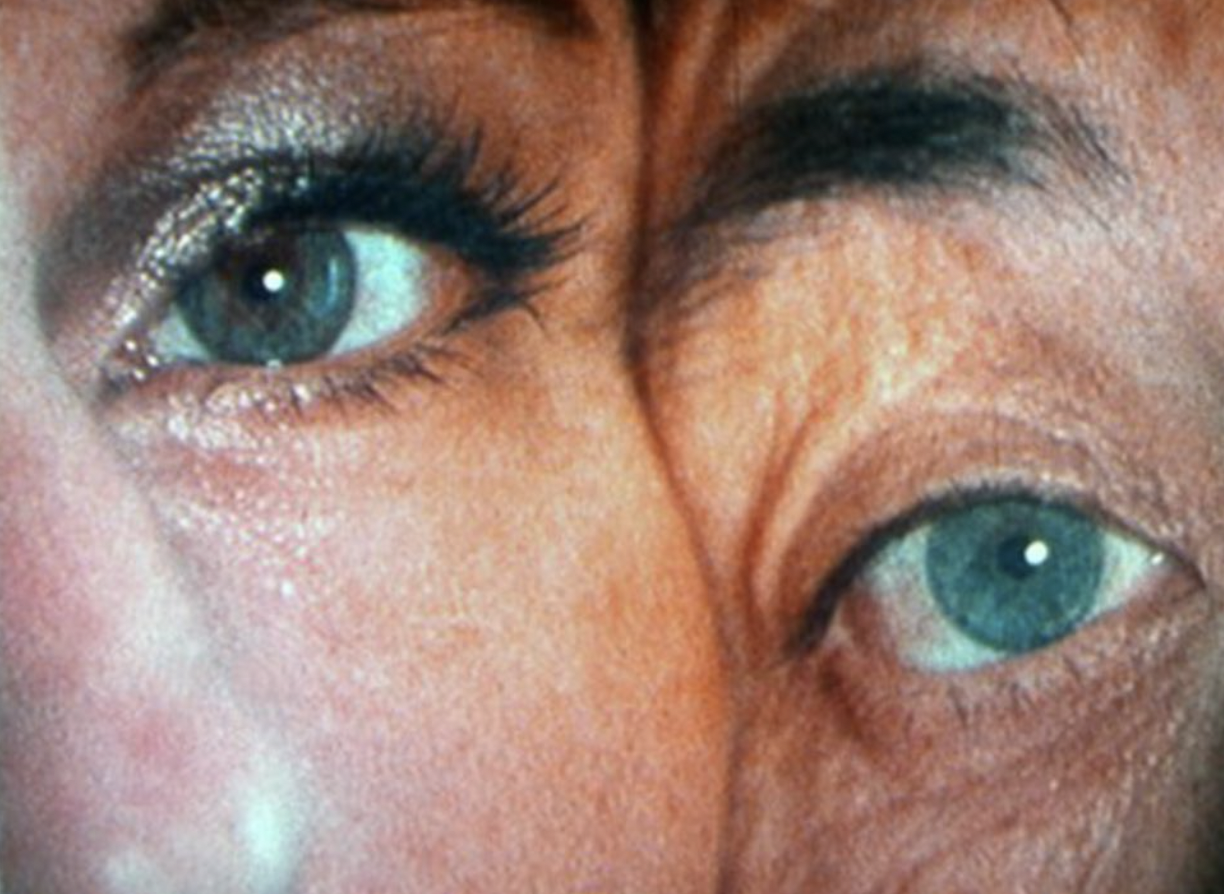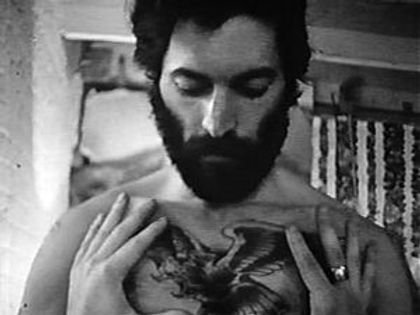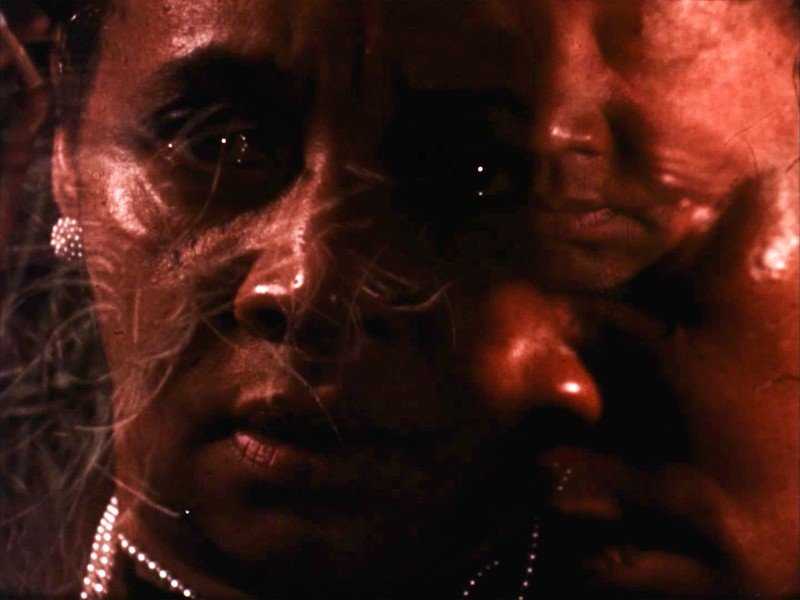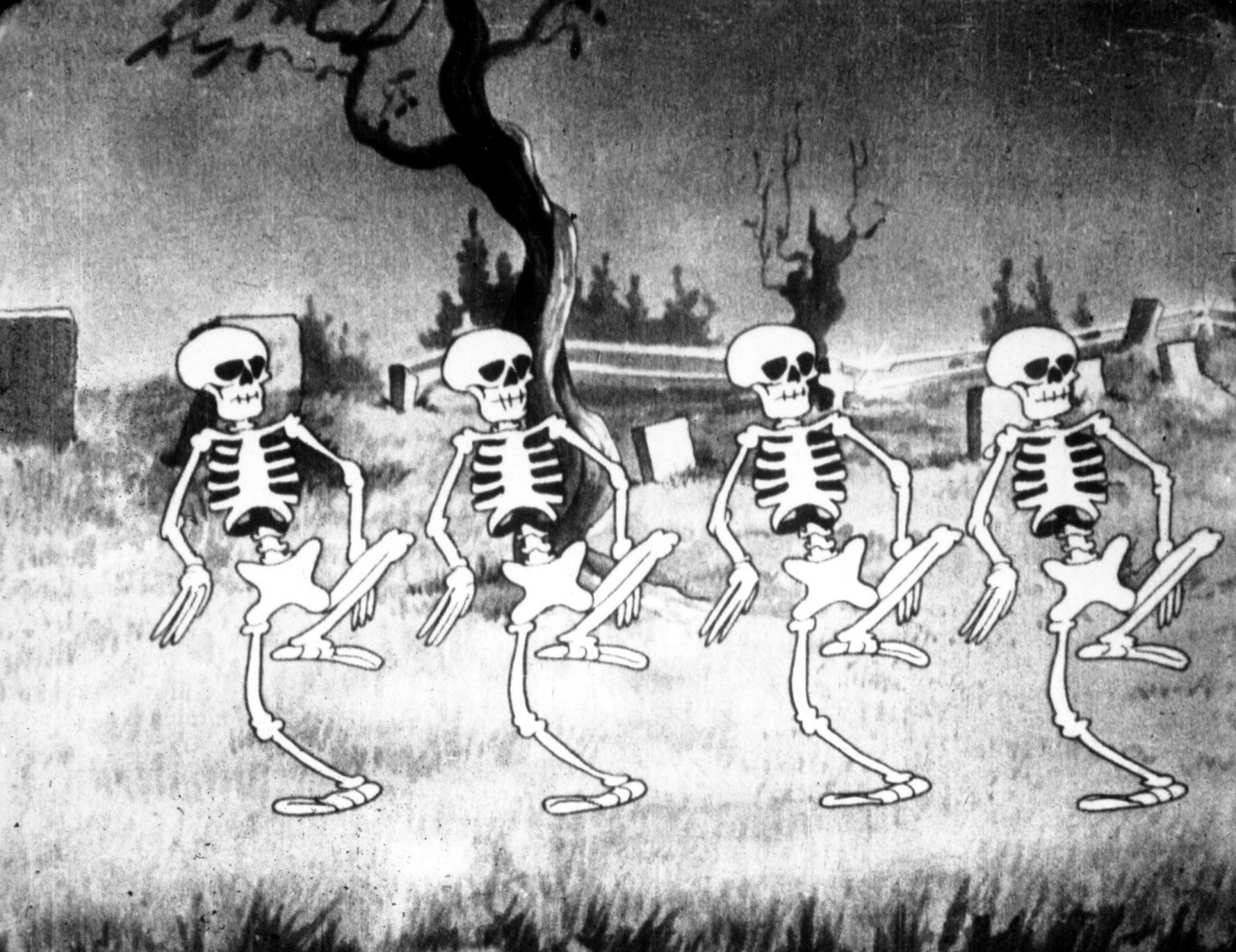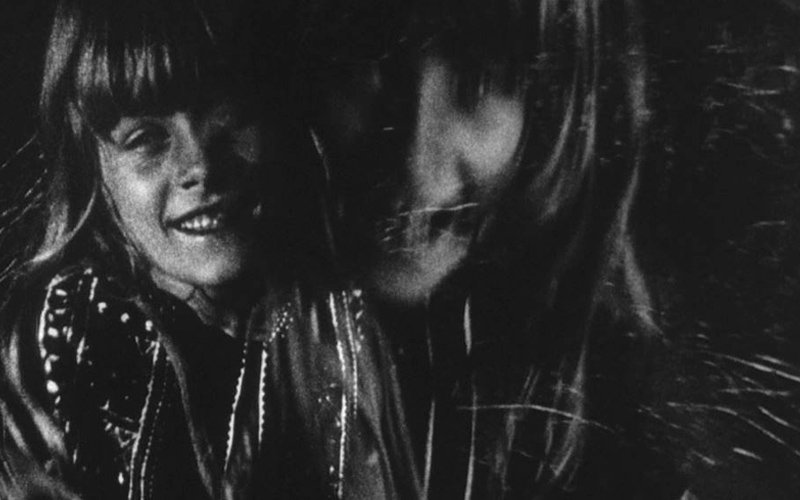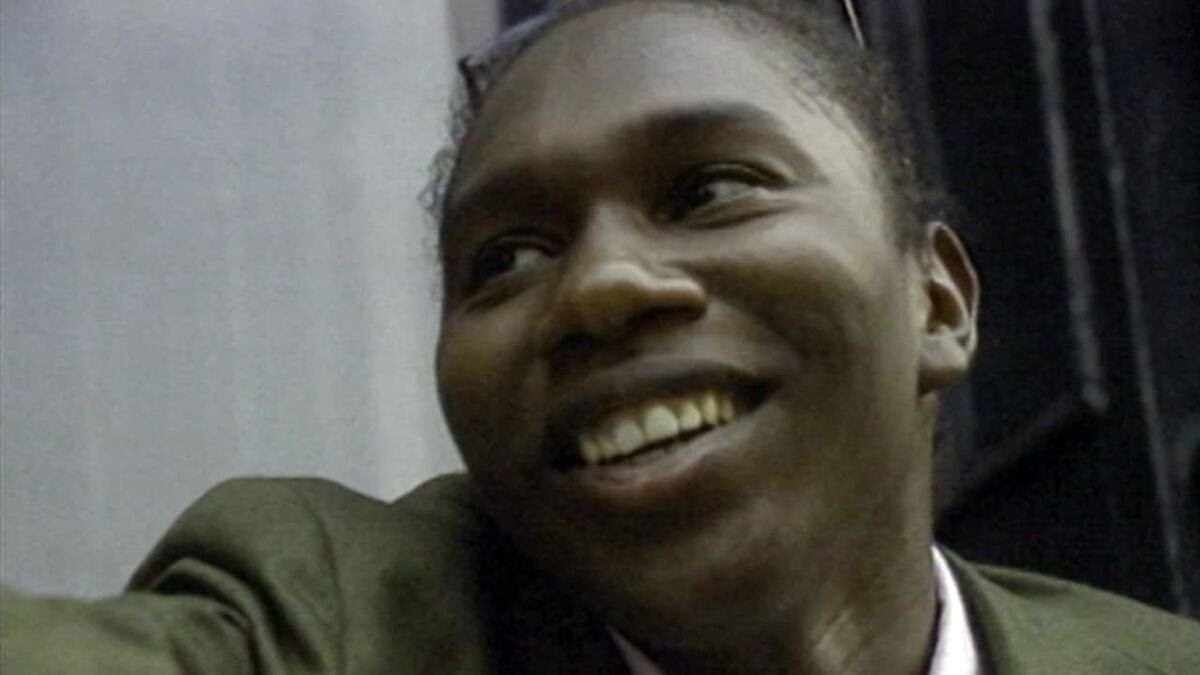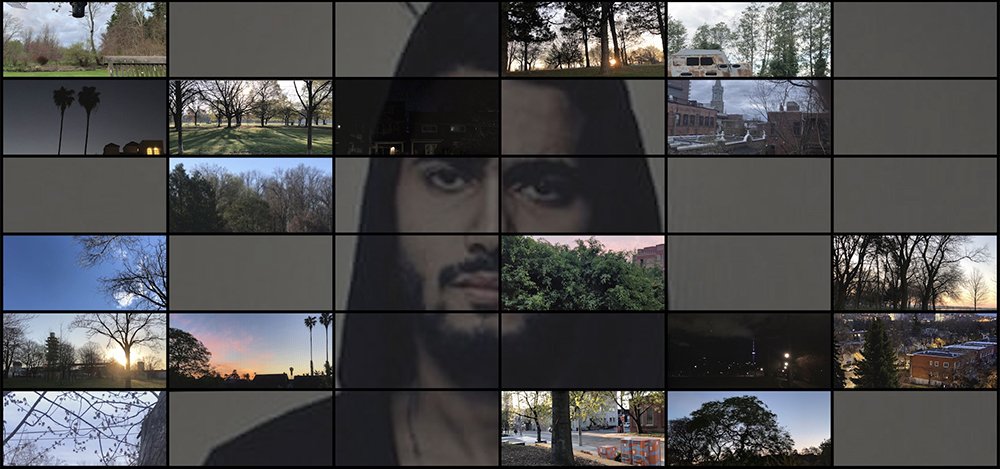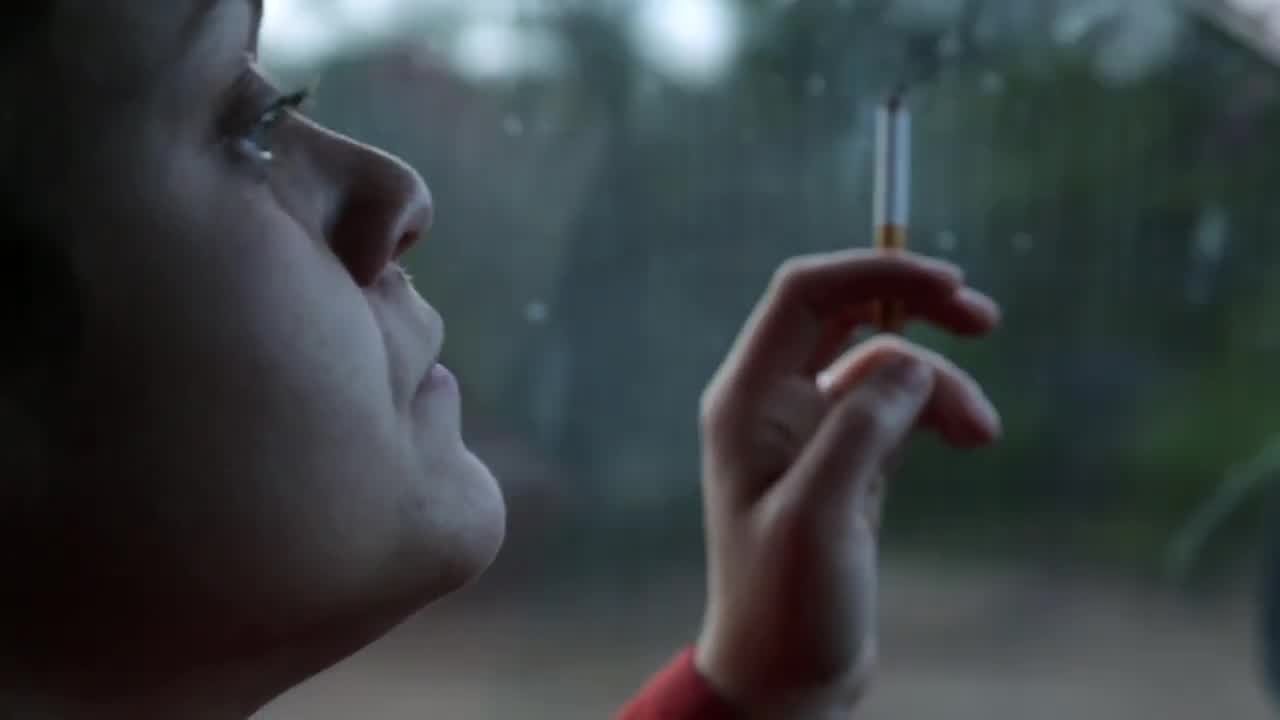The 68th Flaherty Film Seminar
Queer World-Mending
Programs
Program 1
Saturday June 17
Autre fois j’ai aimé une femme / Once I Loved a Woman
Autre fois j’ai aimé une femme / Once I Loved a Woman | Edward Owens, 24 min, 1966, USA
In November 1966, Owens completed his first film Autre fois j’ai aimé une femme. Upon viewing it, his teacher Gregory Markopoulos wrote: [Owens] may well be one of the few for whom amateur and professional need have no significance whatsoever: true to his own native talents, with grim determination uncanny, whether the mind in the arts is for or against beauty or its opposite twin, chaos. —The Film-makers’ Cooperative
Sync Touch
Sync Touch | Barbara Hammer, 10 min, 1981, USA
A lesbian/feminist aesthetic proposing the connection between touch and sight to be the basis for a “new cinema.” The film explores the tactile child nature within the adult woman filmmaker, the connection between sexuality and filmmaking, and the scientific analysis of the sense of touch. | Courtesy of the Estate of Barbara Hammer, New York and Electronic Arts Intermix (EAI), New York.
Multiple Orgasm
Multiple Orgasm | Barbara Hammer, 6 min, 1976, USA
A sensual, explicit film that says just what it is plus visual overlays of erotic rock and cave formations. | This film was preserved by Electronic Arts Intermix and the Academy Film Archive through the National Film Preservation Foundation’s Avant-Garde Masters Grant program and The Film Foundation. Funding provided by the George Lucas Family Foundation. Courtesy of the Estate of Barbara Hammer, New York, and Electronic Arts Intermix (EAI), New York.
Loads
Loads | Curt McDowell, 22 min, 1980, USA
McDowell offers an account of his “adventures with straight boys and the hospitality he extends to them.” William E. Jones writes: “Curt was a sexual pioneer, making movies about practices that most men preferred to keep quiet, then as now. Curt found his own fun, and most importantly for him as an artist, he also found a number of men who were vain, indifferent or desperate enough to be filmed while they reached their climax.” Preserved by the Academy Film Archive.
The Eddies
The Eddies | Angelo Madsen Minax, 16 min, 2018, USA
From below ground, a man named Eddie describes flood lines, levees, and trivial histories of the crumbling infrastructure of Memphis, TN. In this same city, the filmmaker, a recent transsexual transplant, watches war films and contemplates masculine connectivity as he attempts to integrate into the American South. He posts a Craigslist ad asking men to masturbate on-camera with their firearms. He receives a single response from a man whose name is also Eddie.
Stay with Me, the World Is a Devastating Place
Stay with Me, the World Is a Devastating Place | Angelo Madsen Minax, 9 min, 2021, USA
The result of a deep dive into the Channel 8 News archive in Dallas, a group of news anchors, politicians, athletes, celebrities, and Texan bystanders time travel from the year 1970 to heed a dire warning.
Curious About Existence
Curious About Existence | Emily Vey Duke & Cooper Battersby, 11 min, 2003, Canada/USA
Curious About Existence is a collection of short episodes incorporating music, animation, and live-action. It employs a deft combination of humor and humanism to maintain the engagement of the viewer as they are drawn through a number of divergent narrative worlds. The thread that holds these worlds together is a persistent curiosity about the spiritual and material world and its inhabitants: humans, animals, the laws of nature, and so on.
Program 02
Sunday June 18
Lessons in Baby Dyke Theory
Lessons in Baby Dyke Theory | Theo Jean Cuthand, 3 min, 1995, Canada
In 1995, when Theo Jean Cuthand was sixteen, they felt like the only lesbian at their Saskatoon high school. This turned out to be untrue, but the lack of visibility coupled with the lack of representation of Queer teenagers in the 90s inspired their video — a comedic short about teenage lesbian loneliness and trying to bribe classmates to come out with the promise of candy.
Working Baby Dyke Theory
Working Baby Dyke Theory | Theo Jean Cuthand, 1997, 6 min, Canada
A teenage lesbian’s attempts to form friendships with older lesbians lead her on a disturbing ride through the ageist terrain of the dyke community.
Untouchable
Untouchable | Theo Jean Cuthand, 4 min, 1998, Canada
A girl with a bad habit of falling for older women befriends a boy lover. This video is an examination of relationships between adults and teenagers. It involves ice cream trucks and bowie knives.
Helpless Maiden Makes an “I” Statement
Helpless Maiden Makes an “I” Statement | Theo Jean Cuthand, 6 min, 1999, Canada
By using clips of evil queens/witches this video plays off the sadomasochistic lesbo-erotic subtexts commonly found in children’s entertainment. A helpless maiden is tiring of her consensual s/m relationship with her lover and “evil” queen. She wants to break up. An impassioned monologue in a dungeon with our heroine in wrist cuffs quickly becomes an emotionally messy ending in flames. This video was inspired by the artist’s own childhood “kiddie porn”— Disney movies which turned her on to no end and kicked off many prepubescent masturbation sessions.
Anhedonia
Anhedonia | Theo Jean Cuthand, 10 min, 1999, Canada
Anhedonia doesn’t play to the back of the church. It shoots directly to the point, with poetry and images that evoke controversy in one mindset and passion in another. Depression and suicide are met head-on with Cuthand’s honesty. Anhedonia shocks people into opening their eyes to the source of the illness in the Aboriginal community. Statistics, split images, words, and flesh meld together, making this short film long on compassion, screaming out for help and recognition of the mentally ill’s dream of someday having a normal life.
You Are a Lesbian Vampire
You Are a Lesbian Vampire | Theo Jean Cuthand, 3 min, 2008, Canada
In the dark night of a prairie city, a vampire considers her future with a fetching mortal. But requiring blood for sustenance brings a host of problems to the relationship.
Bigger on the Inside
Bigger on the Inside | Angelo Madsen Minax, 12 min, 2022, USA
From an isolated wooded cabin a trans man stargazes, Scruff chats with guys, watches YouTube tutorials, takes drugs, and lies about taking drugs — feeling his way through a cosmology of embodiment. Relative to the immensity of longing, the bodily insides become both portal and lens through which to probe the porousness between interior and exterior, the micro and macro. Nudes and landscapes are equally erotic, as Eros is an issue of boundaries: When I desire you, a part of me is gone.
The Source Is a Hole
The Source Is a Hole | Angelo Madsen Minax, 24 min, 2017, USA | A treatise on transexual mourning told via love letters to goddesses.
No Show Girls
No Show Girls | Angelo Madsen Minax, 4 min, 2012, USA
A silent transexual striptease.
Program 03
Sunday June 18
Puce Moment
Puce Moment | Kenneth Anger, 7 min, 1949, USA
The film reflects Anger’s concerns with the myths and decline of Hollywood, as well as with the ritual of dressing, with the movement from the interior to the exterior, and with color and sound synchronization. —American Federation of Arts
Private Imaginings and Narrative Facts
Private Imaginings and Narrative Facts | Edward Owens, 6 min, 1966, USA
A montage of still and moving images, mixing and alternating black people and white people, fantasy and reality, a presidential suite and a mother’s kitchen. Brilliantly colored and nostalgic, it comprises a magical transformation of painterly collage and still photographic sensibility into filmic time and space. —Charles Boultenhouse
Remembrance: A Portrait Study
Remembrance: A Portrait Study | Edward Owens, 6 min, 1967, USA
A filmic portrait of the artist’s mother, Mildered Owens, and her friends Irene Collins and Nettie Thomas, set to a score of 1950s and 1960s hit songs. Using Baroque lighting techniques, Owens captures the three women drinking and lounging one evening.
—Tate Museum
Strange Space
Strange Space | Leslie Thornton and Ron Vawter, 4 min, 1993, USA
This collaborative work, created specifically for the 1992 Day Without Art/AIDS Awareness Day, addresses what Thornton terms “the relationship between the medicalization of the body and the personal.” While the actor Ron Vawter reads aloud from a poem by Rilke, a doctor is heard discussing Vawter’s medical condition. Medical photographs of internal organs and images of the moon’s surface create landscapes of inner and outer space. This haunting rumination suggests the disparity between medical interpretations and personal experiences of physicality and mortality.
The Last Time I Saw Ron
The Last Time I Saw Ron | Leslie Thornton,12 min, 1994, USA
Arising out of a film and theatrical collaboration with the late Ron Vawter, this moving elegy to his memory employs footage of Vawter taken just before his death, as well as starkly beautiful sequences of distant human forms.
Crossing
Crossing | James Richards & Leslie Thornton 19 min, 2016, Germany/USA
Crossing emerged not from a linear mode, but from a constant trading and reworking of ideas — a porous movement that switches between menace, anachronism and dream. The work exudes the pleasure of grasping for a new and yet shared language, where one’s decisions flow in and out of another’s. Harnessing an associative logic that guided its construction early on, Crossing takes the material undercurrents of Richards’ Radio At Night (2015) and Thornton’s They Were Just People (2016) as its dual starting points. This is a work full of overlays and sutures, creatures artificial and living. Everywhere in the video one sees not just holes but eyes. This, after all, is a dense habitat, teaming with life — stormy, wet, fecund. -—Mason Leaver-Yap, “James Richards and Leslie Thornton’s Crossing: Deep Water”, 2016
The Misty Suite
The Misty Suite | James Richards, 6 min, 2009, UK
The Misty Suite begins in silence with shadowy images hard to identify. After almost two minutes there are fragments of sound, and then an actor reading from a John Updike poem, taken from a late night radio broadcast. This is laid over what looks like an industrial film about face recognition software. After feeling somewhat alienated the viewer is then drawn in via a series of slow moving zooms cribbed from Nightmare on Elm Street (1984), an instructional video featuring a drawing class, and a journey into the cosmos taken from who-knows-where. Over the end of this sequence he has synced more poetry. An unknown poet softly recites: “Bear down, breath… Bear down, bear down, breath…” Seduced, bewitched, and then released, the effect is like waking from a particularly fuzzy erotic dream and finding yourself staring at the DVD screen saver… it’s now late, and someone is singing about loneliness.
Rosebud
Rosebud | James Richards, 13 min, 2013, UK/Japan
Rosebud takes as its starting point a series of images found by Richards in a Tokyo library. Filming the open pages of monographs of Robert Mapplethorpe, Man Ray, and Larry Clark’s works, amongst others, Richards searches over areas where the print has been carefully sandpapered away. Japan’s obscenity laws prohibit images of nudity and sexual imagery, meaning that any imported printed matter deemed “too arousing” is carefully censored by customs officials. Scratched back to the blank support of the material paper, a culture of desexualisation is captured which is both violent and devotional in its intensity. Through the process of erasure a further potency is overlaid, where the void of desire is sutured into vision.
Program 04
Sunday June 18
Girl Talk
Girl Talk | Wu Tsang, 5 min, 2015, USA
Girl Talk features author and scholar Fred Moten dancing in slow motion, with a Josiah Wise rendition of the jazz standard playing over the performance. In light drag — a studded cloak hanging loosely over his body — Moten spins in a sunny garden. The amateur nature of the performance at times renders it less an exploration of identity shifting than observation of the collaboration. The power dynamics are in flux throughout, as the dominant discipline of each performer — text and speech for Moten, visual and physical communication for Tsang — takes alternate precedence. Each party has their moments of vulnerability and domination, exchange and play and allowance leading to what comes.
Wildness
Wildness | Wu Tsang, 74 min, 2012, USA
Wildness is an award-winning documentary about the Silver Platter, a historic bar that is a home to Latina and immigrant transgender communities in Los Angeles. With a magical-realist flourish, the bar itself becomes a character, narrating what happens when a group of young artists create a weekly performance art/dance party, which explodes into creativity and conflict. At the Silver Platter, the search for answers to these questions creates coalitions across generations.
Program 05
Monday June 19
The Wind Sleeps Standing Up
If From Every Tongue It Drips
The Wind Sleeps Standing Up | Sharlene Bamboat, 12 min, 2017, Canada/Pakistan
Memory and biography are examined through experiments in narration as Bamboat plays with ambiguous boundaries between fact and fiction. Lists of personal preferences of various quotidian textures such as pop culture, food, and sexuality are described both in first and third person, sketchinga constellation of clues to form a biography. Footage shot by the artist in Pakistan several years apart becomes both an indicator of image technology and a metaphor for memory. —Images Festival
If From Every Tongue It Drips | Sharlene Bamboat, 68 min, 2021, Canada/Sri Lanka/UK
If From Every Tongue It Drips is a documentary film that explores questions of distance and proximity, identity and otherness, through scenes from the daily interactions between two queer women — a poet and a cameraperson. Created between three locations: Montreal, Batticaloa, and the Isle of Skye, and connected through languages — Urdu, Tamil, and English, personal and national histories, music and dance, and the gaze of the camera lens, they explore subjects both expansively cosmic and intimately close — from quantum superposition to the links between British colonialism and Indian nationalism.
Program 06
Monday June 19
3x3x6 10 cases 10 films | Shu Lea Cheang, 100 min, 2019, Taiwan/Germany
3x3x6 refers to a highly surveilled industrial imprisonment: a three by three square-meter cell constantly monitored by six cameras. 3x3x6, a mixed media installation presented at Venice Biennale 2019, restages the four rooms of Palazzo delle Prigioni — a Venetian prison from the sixteenth century in operation until 1922 — as a high-tech surveillance space in which the stories of the ten prisoners across time, space, histories, and cultures unfold. Taking as its starting point the story of libertine writer Giacomo Casanova, imprisoned in the Prigioni in 1755, 3x3x6 10 cases 10 films recounts ten historical and contemporary cases of subjects incarcerated because of gender or sexual dissent, including Marquis de Sade and Michel Foucault, as well as seven contemporary cases. Borrowing from legal documents, fake news, and historical accounts, the ten fictionalized portraits are expanded with myths and fantasies to construct a collective counter-history of sexuality, where trans-punk-science fiction, queer, and anti-colonial imaginations provide visual and critical frameworks. Ultimately, these ten cases recount the histories of subjection and resistance, aiming to activate critical proliferation of poetic and political actions for digital times.
Program 07
Tuesday June 20
Bad Ideas for Paradise
Bad Ideas for Paradise | Emily Vey Duke & Cooper Battersby, 20 min, 2001, Canada/USA
Funny, touching, and ambitious in scope, Bad Ideas for Paradise deals with themes of addiction, spirituality, identity, relationship dynamics, and the ongoing quest for joy.
Songs of Praise for the Heart Beyond Cure
Songs of Praise for the Heart Beyond Cure | Emily Vey Duke & Cooper Battersby, 14 min, 2006, Canada/USA
Rather than offering transcendence or redemption, Songs of Praise for the Heart Beyond Cure suggests that the distinction between desperation and hope is a question of degree and not kind. Critic Sarah Milroy writes: “To describe Cooper Battersby and Emily Vey Duke’s new video as ironic doesn’t do it justice. Irony implies brittleness, cleverness, and world weariness, but these two artists have a sense of wonder at the endearing weirdness of life and all the vulnerable, furry little creatures immersed in it (mostly us). Songs of Praise consists of a sequence of vignettes that share a kind of bleak humor, but the force of these artists’ imaginations makes the whole anything but depressing.”
Lesser Apes
Lesser Apes | Cooper Battersby & Emily Vey Duke, 13 min, 2011, Canada/USA
Lesser Apes tells the story of a love affair between primatologist Farrah and female bonobo ape Meema. Bonobos are the species with which humans share the most DNA, but unlike our species, they are matriarchal, live with limited conflict and are unabashedly sexual. A paean to perversion, the film combines animation, live action and song to challenge attitudes about sex, language, and our relationship to nature.
The Infernal Grove
The Infernal Grove | Emily Vey Duke & Cooper Battersby, 38 min, 2021-23, Canada/USA
The Infernal Grove is a cross-disciplinary art project about drugs, crime, addiction, and recovery. It amplifies the message of harm reductionists, who advocate for a clean supply of drugs and safe, drug-user-led spaces in which to take them. The project provides an unconditional forum for dialogue among people with lived experience of drug use, including those dealing with legal outcomes of drug prohibition. It reveals the intersection of addiction and power; addiction read through the lens of material history, social difference, and social justice.
60 Unit: Bruise
60 Unit: Bruise | Paul Wong, 5 min, 1976, Canada
One of the first experiments with a color Portapak video camera in Canada. We see Ken Fletcher draw blood out of his arm with a syringe and then inject it into the back of Paul Wong, causing a random pattern of bruising to appear. This simple document captures a modern blood-brother ritual — with implicit reference to drug use — performed in innocence, though startling to an AIDS-aware audience.
Perfect Day
Perfect Day | Paul Wong, 8 min, 2007, Canada
The artist records himself at home proudly indulging in the happiness of a drug-inspired perfect day. The music of Lou Reed: “Heroin” and “Perfect Day.” Recorded on Sunday — edited on Monday. Be Happy.
Program 08
Tuesday June 20
La Chambre
La Chambre | Chantal Akerman, 11 min, 1972, USA
In Akerman’s early short film La Chambre, we see the furniture and clutter of one small apartment room become the subject of a moving still life — with Akerman herself staring back at us. This breakthrough formal experiment is the first film the director made in New York. | Restored by CINEMATEK and the Fondation Chantal Akerman.
Man’s Country
Man’s Country | Amina Ross, 8 min, 2021, USA
Man’s Country Chicago — at forty-four, the city’s oldest gay bathhouse — closed its doors on New Year’s Eve 2017 with a thirteen-hour-long party called Loose Ends. While living in Chicago’s Andersonville neighborhood in the early 2010s, Amina Ross often passed the bathhouse in its final months of operation, curious about what lay inside but concerned that they wouldn’t be admitted because of their embodiment. Ross has used publicly available footage of Man’s Country’s interior to create a three dimensional animated model of the club’s lounge and performance space, placing themself within the architecture virtually. This representation of a specific place in time becomes the vehicle for expansive visual-spatial thinking about structures coming undone, manhood, personhood, and belonging. –John Neff
Eclipsing (Body)
Eclipsing (Body) | Amina Ross, 7 min, 2014, USA
Within this work the artist attempts to embody the definition of “to eclipse.”
We hold where study
We hold where study | Wu Tsang, 19 min, 2017, USA
We hold where study is a short experimental film that takes a choreographic approach to image making and mourning. The film enacts a series of duets, both within and between images. Featuring choreography by boychild with Josh Johnson, and Ligia Lewis with Jonathan Gonzalez. Original music by Bendik Giske. Inspired by the essay “Leave Our Mikes Alone” by Fred Moten and Stefano Harney (authors of The Undercommons), the film seeks passage to sociality through the opening of impossible images.
One emerging from a point of view
One emerging from a point of view | Wu Tsang, 43 min, 2019, Greece
In One emerging from a point of view, the artist continues an ongoing exploration of a “third” space between two overlapping video projections, focusing on this overlap to create visual entanglement. As images cut and bleed into each other, two disparate narratives intertwine through synchronised camera choreography. Set three years ago on the northeastern shore of Lesbos, Greece, the work revolves around a scenario in which two women cross paths — although they never meet. One is a young woman from Morocco (Yassmine Flowers), who arrives in Athens after many months of travel through Turkey and Lesbos’ Moria camp. The other is a photojournalist (Eirini Vourloumis) assigned to document the “crisis,” who becomes personally involved with the fishing village of Skala Sikamineas, where locals have been first responders to the mass influx of refugees coming mostly from Syria, Iraq, Afghanistan, and North Africa. Since 2011, more than half a million refugees have crossed into Europe through the Greek island of Lesbos, located in the Northern Aegean Sea off the coast of Turkey. Rather than attempt to document a “truth,” Tsang takes a magical realist approach as she works in collaboration with her subjects to create a hybrid fantasy. Drawing from history, mythology, and science-fiction, her film situates the two parallel narratives within both real and imagined landscapes in order to tell the story of the island and the migration across interconnected and overlapping space and time.
Program 09
Tuesday June 20
The Skeleton Dance
The Skeleton Dance | Walt Disney, 6 min, 1929, USA
The Skeleton Dance, released in 1929, was the first in Walt Disney and Carl Stalling’s Silly Symphonies series. When night falls at a church cemetery, amidst howling dogs, hooting owls, and fighting cats, four skeletons rise from their graves for macabre merriment. Dancing and playing music by using each other as instruments, the skeletons party until the rising of the sun, where they frantically rush back into their graves, forming a skeletal chimera to get back faster.
Tse / Out
Tse / Out | Roee Rosen, 34 min, 2010, Israel
Out’s central scene presents a domination/submission thrashing scene, performed by two women whose real-life preferences entail BDSM. But in this session, the painful blows meted by the Dom cause the sub to spew out sentences, all of which are quotes from Israel’s minister of foreign affairs, Avigdor Lieberman, an extreme right-wing politician. Thus, a scene of erotic pleasure and pain becomes a political exorcism, and the film itself a hybrid between a documentary and a fictional scene harking to horror movies and possession. The ritual at the center of the work is framed by two additional scenes, each with its own distinct cinematic style. First, a preceding interview with the two participants seems at the beginning to be a straightforward documentary about their own experiences within the Israeli BDSM scene but soon transforms into an exposition of the premise by which one is possessed, the other an exorcist. The final musical scene is a song set to the words of the Russian poet Esenin’s “Letter to Mother.” Executed as a one-shot, it complicates the emotional resonance of what preceded it but also pays homage to the final scene of another film that deals with hybridity, radical sexuality, and politics: Dusan Makavejev’s WR: Mysteries of the Organism (1971).
Seizure
Seizure | Pat Hearn & Shelley Lake, 17 min, 1980, USA
Daubed head to toe in various colors of fluorescent paint, a nude Hearn appears in front of Lake’s camera to a dance music soundtrack played on a boom box. The strobe machine flashes light against Hearn’s body as she moves and dances, and the light repeatedly throws the automatic exposure of the camera off-balance as the image vertiginously zooms in and out of the scene. Halfway through the video, the camera falls to the floor, the music cuts out, and panicked voices can be heard off-camera. The scene then switches to a static shot of Hearn again under strobe lights, this time within the context of a hospital EEG test. The off-camera voice of a female clinician calmly explains the EEG process, remarking that strobe lighting can artificially induce seizures, and that the fit zone of such a seizure is approximately sixteen flashes per second. The film concludes with Hearn’s EEG recording captured on camera. –Mason Leaver-Yap, “Passing Time: Pat Hearn, 1980/81” | Contains scenes with strobe lights.
When We Were Monsters
When We Were Monsters | Steve Reinke & James Richards, 20 min, 2020, USA/Germany
Cinema is always Frankenstein; a composite being. Indeed, what is more monstrous than the cut? The filmic severing of an image from its origin reveals it, making it available for inspection. Working intermittently together since 2008, Steve Reinke and James Richards have been exchanging material across the Atlantic to their respective studios in Chicago and Berlin. Drawing upon a loose shared archive of found and self-shot footage, music, essays and, poetry, these dismembered fragments slowly assemble into an exquisite corpse. The starting point for When We Were Monsters was a video tape of projection footage made by the artist Gretchen Bender. Originally edited as a series of video projections for Bill T Jones’ dance piece Still/Here for New York’s Whitney Museum in 1994, Bender drew upon a large cache of forensic images from a plastic surgeon. Clinical images of infections, deformities, and morbid injuries are turned by Bender into an abject flicker-film. Made during the beginning of the Covid-19 pandemic 2020, When We Were Monsters reflects lockdown existentialism with its combination of molecular porosity and existential vastness. Expanding Bender’s medical gaze to include a broader scientific gaze, the film combines new sequences and animations, interleaving texts and a rich soundtrack of audio and spoken word. Often collapsing into an abstract of erotics, we see glimpses of Ivan Pavlov’s ghost dogs, fungi and fovea, wounds, flowers, dust and stains, fire ceremonies, organic flickering, hallucinations, and intoxicated language. Contains scenes with strobe lights.
Program 10
Wednesday June 21
Kafka for Kids
Kafka for Kids | Roee Rosen, 111 min, 2022, Israel
Kafka for Kids is a musical comedy set up as the first chapter of a TV series purporting to make Kafka’s tales fit for toddlers, offering a retelling of The Metamorphosis. Whereas the story of Gregor Samsa’s transformation into vermin is rendered in animation based on Rosen’s gouaches, the reading of the story, in live action, occurs in the magical story-house, where an adult reads the story to a nameless child, surrounded by a choir of animistic object-friends, such as Ms. Lamp and Mr. Table, who also dub Kafka’s stories, and their singinng is supported by a toy orchestra. The film also features ad breaks, which gradually grow more complex and independent. The centrality of the law in Kafka’s writings and thought, and the notion of childhood, leads towards the end of the film to a very different realm: an exposition of the complex and troubling ways in which childhood is legally defined in the occupied territories by military law. Through this shift, the film itself undergoes a metamorphosis.
Program 11
Wednesday June 21
Nils Bech (Can’t live if living is without you)
Nils Bech (Can’t live if living is without you) | James Richards, 3 min, 2023, Norway/UK
Performance in car park, Oslo, 2005.
Not Blacking Out, Just Turning the Lights Off | James Richards, 16 min, 2011, UK
Not Blacking Out, Just Turning the Lights Off is concerned with processes of dissolution and exchange, asking what happens along the frayed edges of subjectivity as it meets, or attempts to meet another. The film stalks liminal states of exhaustion and sleep, we see bedrooms and the paraphernalia of intoxication, alongside X-rays, skin, and globular liquids, sequences which build a heightened sense of inside and outside, the tender and the forensic, the sensual image and its abstraction. The soundtrack includes a reading by Judith Grahn of her poem “Plainsong: From an Older Woman to a Younger Woman.” It is an incantation of the spirits passing between two same sex lovers of different ages reflecting on mortality and desire as something physically, and emotionally, transmitted. The film also includes a modulated edit of The Incredible String Bands’ folk-hippy classic “A Very Cellular Song,” the track evoking the sense of cosmic unity when experiencing LSD.
Raking Light
Raking Light | James Richards, 7 min, 2014, UK
Raking Light takes its name from an examination method used in art conservation, where a strong light is shone directly across the surface of a painting to highlight details or irregularities. Looped fragments of moving image gathered from diverse sources including diaristic footage filmed on a hand-held camera and fleeting images from cult films come together to form an elliptical, allusive film about the act of looking, a “study of opacity and sheen.”
Grave
Grave | Beryl Sokoloff, 9 min, 1972, USA | Music by Andres Lewin Richter
My Name Is Oona
My Name Is Oona | Gunvor Nelson, 10 min, 1969, USA
The sound consists of Nelson’s daughter, Oona, repeating the names of the days of the week and saying “My name is Oona”. The latter is edited into an expressive rythmical structure that accompanies the visual structure of the film that plunges into the experience of a child (Filmform). “I think that her world and that of my childhood are mixed in the film. As a child you feel pretty secure in your own world, but the rest is mysterious and scary — maybe monster and trolls are waiting there outside, even if you’ve never seen them before.” —Gunvor Nelson
Radio at Night
Radio at Night | James Richards, 8 min, 2015, Germany
“Radio at Night grapples with the anxiety and pleasure of seeing and sensing in an era saturated by technology. Like his previous work, this short experimental video collages together appropriated footage from highly disparate sources: intimate fragments from cinema and medical film, an extract of an erotic movie that documents an imagined Venetian costume party, news broadcasts, negative footage of seagulls flying over the ocean, and imagery of pigs and fish being processed at a food facility. Radio at Night is especially preoccupied with the act of seeing and the ways technology makes this sensation mechanical. Accompanied by a soundtrack composed by the artist that includes vocal arrangements recorded with British harmony trio Vocal Juice refracted through his sampled electronics. Richards confronts his audience with close ups on faces as his subjects’ eyes dart back and forth across the screen.” —Mason Leaver-Yap | Commissioned by the Walker Art Center with major support from the Bentson Foundation.
Qualities of Life: Living in the Radiant Cold
Qualities of Life: Living in the Radiant Cold | James Richards, 18 min, 2022, Germany
The work is a material and metaphorical endoscope that records and compiles domestic still lifes, detritus, and civic sewage systems into a poetry and music suite to look closer at the private and public dimensions of decay, hygiene, and contagion. Over its stanzas, it focuses with granular attention on the different materials it collects, as if involved in the anamnesis of a self, a body, a house, a city. The film entangles the macro with the micro across nonlinear discourses, from the millennial evolution of bees’ social structure — footage originally filmed by artist and often collaborator Leslie Thornton — to the brief analysis of a body through an MRI scan. One of its guiding forces is a series of images from the archive of Horst Ademeit, whose obsessive, multi-decade imperative was to register the detrimental impact of radiations (invisible, “cold” rays, as he called them) on his body and his surroundings. In another stanza, various erotic, narcotic, and nostalgic remains from Richards’s apartment and studio are gathered, scanned, and animated into mental conglomerates. Throughout the film objects, subjects, bodies, and images solidify for a moment before smearing their borders, drifting into something else.
Midnight Screening
Wednesday June 21
FLUIDØ
FLUIDØ | Shu Lea Cheang, 80 min, 2017, USA/Germany
Set in the post-AIDS future of 2060, where the Government is the first to declare the era AIDS FREE, mutated AIDS viruses give birth to ZERO GEN — humans that have genetically evolved in a unique way. These gender fluid ZERO GENs are the bio-drug carriers whose white fluid is the hypernarcotic for the 21st century, taking over the markets of the 20th century white powder high. The ejaculate of these beings is intoxicating and the new form of sexual commodity in the future. The new drug, code named DELTA, diffuses through skin contact and creates an addictive high. | Contains scenes with strobe lights and explicit images.
Program 12
Thursday June 22
Affirmations
Affirmations | Marlon Riggs, 10 min, 1990, USA
Riggs expresses the hopes, dreams, and desires of gay Black men in this ode to queer African American empowerment. Built around outtakes of interview and protest footage from Tongues Untied, Affirmations begins as a candid, sex-positive confessional by poet Reginald T. Jackson about first-time penetration and evolves into a rousing chorus of calls for freedom, recognition, and inclusion.
Medicine Bundle
Medicine Bundle | Theo Jean Cuthand, 10 min, 2020, Canada
“Medicine Bundle is about a bundle that was used in my family to heal my Great Great Grandfather from a smallpox epidemic and a life-threatening wound from a gatling gun used against him during the Battle Of Cutknife Hill in 1885. The bundle was again used in 1918 when my Grandfather contracted the Spanish flu as a baby. It was buried in an unmarked grave to protect it from grave robbers, but the spirit within the bundle has continued to protect our family from more modern psychological effects of colonization like depression. As I finished this video, a pandemic was raging over the globe, and I wondered if the bundle would continue to protect us now as it has in the past.”
Extractions
Extractions | Theo Jean Cuthand, 15 min, 2019, Canada
A personal film about Canada’s Resource Extraction Industry and the filmmaker’s role being both a beneficiary and an adversary, as an Indigenous person. Cuthand parallels resource extraction with the rampant apprehension of Indigenous children and babies for the profitable foster care system in Canada. The filmmaker turns his attention to his own desire for children, and the processes he went through to retrieve frozen eggs to make a Cree baby. Larger problems caused by resource extraction, specifically climate change, threaten the planet and have made many people abandon the idea of reproducing, yet the filmmaker resists abandoning hope.
Specular Cry
Specular Cry | Amina Ross, 3 min, 2019/20, USA
Within this work I render a fragmented eye that cries, in a stuttered and fragmented loop, it contains the reflection of a cityscape. I am curious about black interiority, the space of deep feeling that resides beyond and in spite of visibility. Atop this modeled and animated eye plays a channeled poetic text I wrote during a planetary alignment of Pluto and Venus some years ago. The words came to me just before sleep and I followed them.
Audio produced by Charles Rice (ORPHUN); text written and read by Amina Ross; 3D modeling, animation, and simulation by Amina Ross; 3D modeling and simulation advising by Max Crider.
Both, Instrument & Sound
Both, Instrument & Sound | Sharlene Bamboat, 30 min, 2023, Canada
Both, Instrument & Sound employs tension as an aesthetic strategy, to explore solidarity, collective struggle and the transformation of these values under neoliberalism. The film follows the life of Tony over two years as he describes his process of political activism from the 1970s onwards, which cannot be disentangled from his friendships and his lovers. In the face of a growing politics and language of individualism Both, Instrument & Sound questions how our discourses and practices of solidarity have changed since the rise of neoliberalism. Through hand-processed 16mm film, poetry, and collective listening practices, the collision of flesh and friendship, sonic and visual tension and the complications of solidarity are explored. | Contains scenes with strobe lights.
Bugs and Beasts Before the Law
Bugs and Beasts Before the Law | Bamboat | Mitchell, 33 min, 2019, Germany/Canada/UK
Bugs and Beasts Before the Law is an experimental film that explores the medieval practice of putting animals on trial. This history of colonial law-making forged political and sometimes profane relationships between humans and animals. This essayistic work reimagines common perceptions of legal history and, in doing so, produces a world where past and present, fiction and non-fiction, human and animal fuse.
Program 13
Thursday June 22
Shtei Nashim Ve’Gever / Two Women and a Man
Shtei Nashim Ve’Gever / Two Women and a Man | Roee Rosen, 16 min, 2005, Israel
Roee Rosen dedicated six years to the persona of Jewish Belgian artist and pornographer Justine Frank (1900–1943). Frank, infamous for her concoction of Jewish motifs and explicit erotica, was active both amongst the French Surrealists and, later, the Jewish community in Palestine before the establishment of Israel, managing to provoke anger and hostility in both scenes. The film presents an interview by Frank scholar Joanna Führer-Ha’Sfari (Rosen in drag, with his voice dubbed by a woman) on the occasion of the publication in Hebrew of Sweet Sweat, the pornographic novel Frank authored in 1931. As soon became clear, Führer-Ha’Sfari was highly antagonistic towards Rosen, and only snippets of the interview were used in the program. Führer-Ha’Sfari discusses not only the provocative aspects of Frank’s work, but an earlier work by Rosen, dealing with Nazism and the Holocaust, that stirred a scandal when shown in Israel. The split between two fake personae and Rosen’s own is used to stage a moral split of self-incrimination.
International Dawn Chorus Day
International Dawn Chorus Day | John Greyson, 15 min, 2021, Canada
On International Dawn Chorus Day (May 3, 2020), birds from six continents join a zoom call. They gossip about storms and cats and wires and dates. They talk about Egyptian filmmaker Shady Habash, known for his satiric anti-dictator music videos, who died the day before in Cairo’s notorious Tora prison. They wonder about Egyptian queer activist Sarah Hegazi, famously incarcerated for flying a rainbow flag at a Cairo concert, now living as a refugee in Toronto. They don’t realize that a month later, unable to bear the pain of her prison trauma, Sarah will take her own life.
Reclamation
Reclamation | Theo Jean Cuthand, 13 min, 2018, Canada
Reclamation is a documentary-style imagining of a post-dystopic future in Canada after massive climate change, wars, pollution, and the aftereffects of the large-scale colonial project which has now destroyed the land. When Indigenous people are left behind after a massive exodus by primarily privileged white settlers who have moved to Mars, the original inhabitants of this land cope by trying to restore and rehabilitate the beautiful planet they belong to.
The Lost Art of the Future
The Lost Art of the Future | Theo Jean Cuthand, 4 min, 2022, Canada
In The Lost Art of the Future, Cuthand talks about artists he has known who have passed while living with HIV/AIDS and the art he wishes he had been able to see them make if their lifetimes had been longer.
You Were an Amazement on the Day You Were Born
You Were an Amazement on the Day You Were Born | Emily Vey Duke & Cooper Battersby, 33 min, 2019, Canada/USA
You Were an Amazement on the Day You Were Born is a visually rich film that follows a woman through a life characterized by damage and loss, but in which she finds humor, love, and joy. With a score that follows the span of Lenore’s life, from her birth in the early 1970s to her death in the 2040s, the film takes us from moments of harrowing loss to poignancy and dark humor. Her life is narrated by performers who range in age from nine to sixty-nine, and is beautifully illustrated with images of animals/humans, insects, and landscapes.
Program 14
Thursday June 22
Sodom
Sodom | Luther Price, 16 min, 1989, USA
Sodom is viscerally graphic and disturbing through its hypnotic mirage of human fragment absorbed in mutilation. Based on the biblical story, Sodom recreates this destruction through an editing style that lends itself to a kind of organic image breakdown, creating a collage of moving image.
North by Current
North by Current | Angelo Madsen Minax, 86 min, 2021, USA
After the inconclusive death of his young niece, filmmaker Angelo Madsen Minax returns to his rural Michigan hometown preparing to make a film about a broken criminal justice system. Instead, he pivots to excavate the depths of generational addiction, Christian fervor and trans embodiment. Lyrically assembled images, decades of home movies and ethereal narration form an idiosyncratic and poetic undertow that guides a viewer through lifetimes and relationships. Like the relentless Michigan seasons, the meaning of family shifts, as Madsen, his sister, and his parents strive tirelessly to accept each other. Poised to incite more internal searching than provide clear statements or easy answers, North by Current is a visual rumination on the understated relationships between mothers and children, truths and myths, losses and gains.
Program 15
Friday June 23
In Memoriam: San Francisco Art Institute (1871–2022)
Considered the first art school in the Western US, the SFAI was a hotbed for not only aesthetic but social and sexual experimentation over much of its history. The context of San Francisco as the epicenter of sexual liberation fostered an art school with a particularly libidinal bent. This was most evident in George Kuchar’s classroom, where no-budget filmmaking techniques were learned and boundaries pushed.
“The campus was a pleasant, sun-drenched environment, with any hint of tears and sweat kept to a minimum. At least on the surface. But like the earth beneath our feet, the California experience was riddled with potentially violent cracks that could shake one up pretty bad. We were going to grind the productions out from start to finish, and so the student-teacher movie factory opened for business: the business of education, art, entertainment, and creative expression on a shoestring budget; a kind of trash cinema that used actual trash for sets and strived to elevate the garbage into excrements of excellence. We put our hearts and souls into these movies, along with the rotten acting and inept direction. Without all these elements we would not be human…” —George Kuchar
Club Vatican
Club Vatican | George Kuchar, 17 min, 1984, USA
Kuchar’s childhood was heavily shaped by Catholic sexual repression and guilt. Movies acted as an escape from day-to-day life, a parallel reality that reveled in sin and sensation. Teaching at the libertine San Francisco Art Institute from 1971–2011, Kuchar made numerous hot-blooded, Z-grade “classroom pictures” with his students. Several, including Club Vatican, Motel Capri and Evangelust, act as lascivious collective exorcisms of religious hypocrisy and sexual repression. Club Vatican is one of the most visually sumptuous of Kuchar’s classroom pictures, and was recently restored by the Harvard Film Archive (alongside other of Kuchar’s pedagogical free-for-alls). The frame is packed with visual stimulation and the film unfolds as a series of writhing tableaux depicting clergy and sinners alike in perverse Catholic rites. Kuchar called it “a meditation on religious upheaval via mental strife.”
Video Album 5 / The Thursday People
Video Album 5 / The Thursday People | George Kuchar, 60 min, 1987, USA
The comings and goings of the late underground filmmaker Curt McDowell — and the people and activities that came and went along with him — are the themes that run through this existential diary of daily life. McDowell was dying from AIDS-related illnesses during the production of the diary. Steve Seid describes it: “An elegy for McDowell, the videowork captures Kuchar’s mournful remembrances of his long-lasting friendship with the young filmmaker. But it also has the inquisitive charm, perverse humor, and quirky candor that places Kuchar’s visual expressions in a gritty niche all their own.” The video ultimately leaves open the question of whether Kuchar’s and McDowell’s transgressive filmmaking spirit will be taken up by younger generations, poignantly considering the ravages of time’s passing and the fragility of cultural memory.


